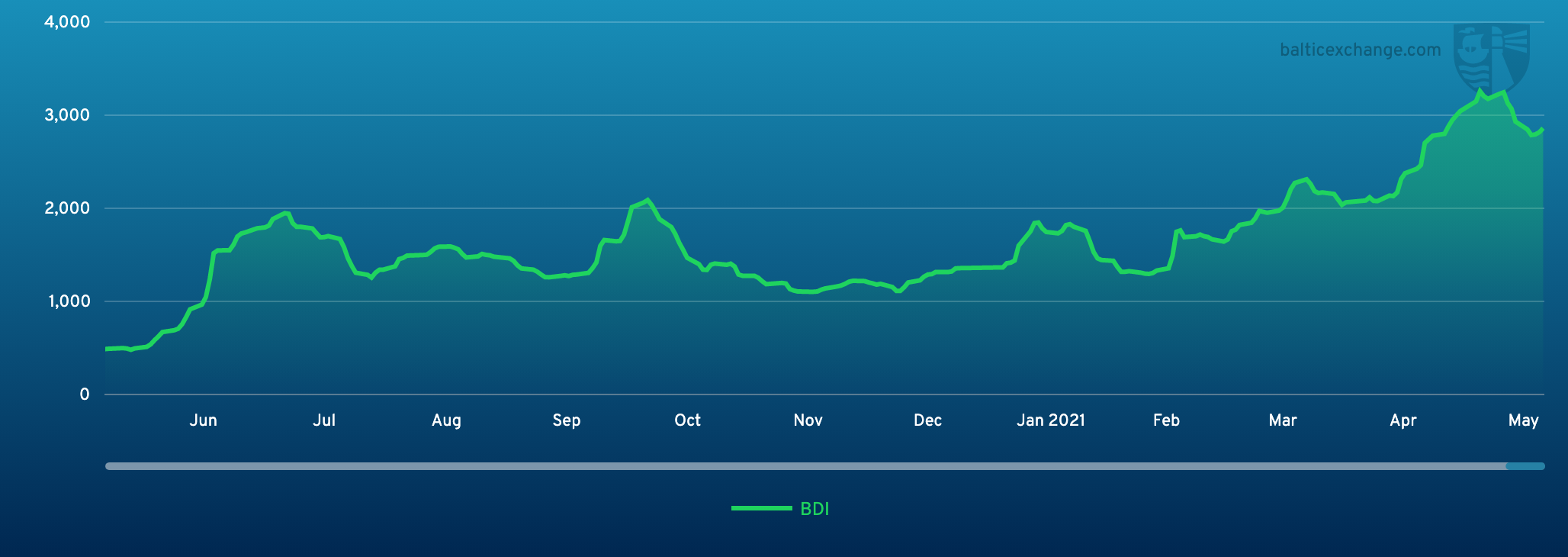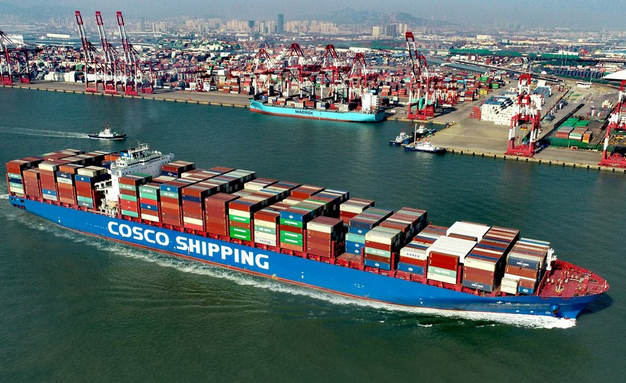BEIJING, May 24 (Xinhua) -- The Baltic Exchange has published its weekly report of the dry and tanker markets for May 17-21, 2021 as below:
Capesize
The Capesize market managed to turn its fortunes around this week stemming the slide from the previous week. Opening the week at $34,542 the 5TC weakened until midweek before posting a solid 959 gain to settle at $32,593. This revival is largely Pacific led with a small assist from the ballaster routes. The North Atlantic remains weak and largely not dropping further due to an already stretched tether to the Pacific Basin. The Transatlantic C8 at $29,790 is currently at a difference of $10,456 to the Transpacific C10 at $40,246. While prone to a volatile price shock due to its minimal cargo and vessel volume, this week the region was largely a bystander. The Brazil to China C3, currently at $26.21, traded in wide spreads this week with neither side making much headway. The route ticked up slightly but little activity was heard. Moving into the new week the sentiment on paper was on the up, whether this is on the back of stronger physical fundaments of maybe just speculators rolling the dice is as yet unknown.
Panamax
The start of the week proved to be a little muted for Panamaxes with mixed opinions on the market with consistently wide bid/offer spreads. The Atlantic saw solid support for the front haul trips from the North Americas, whilst transatlantic demand proved to be weak with rates driven down particularly for the short duration trips. From EC South America, second half June, found some backing whilst the nearby position remained under pressure. An 82,000dwt delivery Singapore agreeing $29,500 via EC South America for trip Far east. In Asia, sturdy demand led to firmer rates from Indonesia assisted midweek with renewed support from ECSA. Elsewhere NoPac proved to be lacking whilst Australia appeared flat all week, with an 81,000dwt delivery Japan achieving $26,850 for a trip via EC Australia redelivery Japan. The FFA market hopped around all week, and period activity was thin overall. However, reports surfaced of an 82,000dwt fixing $25,000 for 12 months.
Ultramax/Supramax
Overall a more positive week for the sector, as more enquiry appeared from the Atlantic giving rise to stronger numbers being available in key areas whilst there remained strong demand from Asia. The BSI saw a week-on-week jump of 111 points, closing at 2,408. Period activity saw a 63,000dwt open China fixing for five to seven months at a healthy $32,000. In the Atlantic, better numbers from the US Gulf saw a 58,000dwt fixing a trip to China at $30,000. Elsewhere, a 55,000dwt open Continent fixing a scrap run to the eastern Mediterranean at $26,000. In Asia, trips back to the Atlantic saw demand with Ultramax sizes seeing in excess of $30,000 to Mediterranean. Otherwise a 58,000dwt open Taiwan was fixed for a nickel ore run via Philippines redelivery China at $32,000. From the Indian Ocean, a 60,000dwt open Arabian Gulf was fixed for a trip to Bangladesh $40,000.
Handysize
In a week which has seen both the Atlantic and Asia markets have limited activity, the BHSI has remained positive this week. Charterers continue to take tonnage in both basins for period, which suggests that some see a firm market for the foreseeable future. A 34,000dwt open in the Sea of Marmara fixed four to six months with redelivery Atlantic at $19,500. In Asia a 34,000dwt was fixed for four to six months with redelivery worldwide at $27,000. A 36,000dwt Logs fitted vessel open in Vanino was fixed for about two to four months at $32,500. East Coast South America has seen more activity this week, a 36,000dwt open in San Lorenzo fixed a trip to Peru at $34,250. In Asia a 32,000dwt open in China fixed basis delivery DOP to the US West Coast at $27,000. In the Arabian Gulf a 37,000dwt fixed a trip to East Coast India with fertilisers at $40,000.
VLCC
In the Middle East the market for 280,000mt to US Gulf (routing via the Cape/Cape) is assessed slightly firmer at WS19-19.5 level, up almost a point from last week. Rates for 270,000mt to China are two points firmer at WS34.5 (showing a round-trip TCE of $1700/day) and overnight reports show a couple of ships on subjects to Malaysian and Chinese charterers at WS35 and WS36 respectively. In the Atlantic, rates for 260,000mt West Africa to China firmed by less than a point to just below WS36 (a round trip TCE of $4.4k/day) and 270,000mt from US Gulf to China saw rates recover about $40k to just over the $4.33m mark (about $7k/day TCE round-trip).
Suezmax
In the 135,000mt Black Sea/Med market rates remain pegged at WS58 (a round-trip TCE of about minus $4k/day), while in the 130,000mt Nigeria/UK Continent market rates have eased another two points to WS49 level (a round trip TCE of $400/day). The market for 140,000mt Basrah/Med remains flat at WS17-17.5 region.
Aframax
In the Mediterranean, the market has improved slightly with rates for 80,000mt Ceyhan/Lavera gaining two points to WS87 (a TCE of about $3k/day basis a round voyage). In Northern Europe rates have slipped, with the market for 80,000mt Cross-North Sea easing four points to WS91 level (about minus $4k/day TCE round trip) while rates for 100,000mt Baltic/UK Continent are down six points to WS67.5 region (a round trip TCE of about $1.8k/day). Across the Atlantic the market’s slow descent continues with rates for 70,000mt Caribbean/US Gulf slipping three points to the WS98.5 mark (a TCE of about $5.2k/day round trip), while for 70,000mt US Gulf/UK Continent rates remain flat at WS77.5 (showing a round trip TCE of $2.2k/day, although basis one-way economics the TCE is considerably better).
Clean
The Colonial Pipeline is now back in action after last week’s cyber attack and consequently rates from US Gulf have plummeted. The market for 38,000mts from US Gulf to UKC now sits at WS77.5/80 region, representing a drop over the week of 25 points. It’s a similar story for cargoes to Brazil where rates are down around 32.5 points at WS112.5 level. By contrast the MR market from Continent/USAC has been relatively steady with rates easing around 2.25 points to WS135 level. The 37,000mts trade from Continent to West Africa has largely followed suit, down around 3 points in the mid WS140s. In the Middle East Gulf, LR2 owners have enjoyed a better week with rates for 75,000mts to Japan gaining 7.5 points to WS91.25 . However, the LR1s have come under pressure here and have eased from low WS90s to very high WS80s, basis 55,000mts cargo. The MRs here have also found it hard going and the market for 35,000mts in to East Africa has slipped around seven points to WS155 region. For owners plying the 30,000mts clean trade in the Mediterranean, it has been a volatile week with rates initially gaining around 12 points to WS180 for West Med load, and East Med load had been as high as WS185 with Black Sea paying 10 points more. But things have slowed down and in the West Med Petroineos are now said to have paid WS165 for Lavera load and with tonnage willing to ballast down from the Continent, charterers have had plenty of choice here.
Headquartered in London and a subsidiary of the Singapore Exchange (SGX), the Baltic Exchange publishes a range of indices and assessments which provide an accurate and independent benchmark of the cost of transporting commodities and goods by sea. These include the Baltic Dry Index (BDI), the dry bulk shipping industry's best known indicator. Published daily since 1985, this provides a snapshot of the daily spot market earnings of capesize, panamax and supramax vessel types on the world's key trading routes.

Chart shows Baltic Dry Index (BDI) during May 20, 2020 to May 21, 2021

Baltic Forward Assessment for BDI
In March 2018 the BDI was re-weighted and is published using the following ratios of timecharter assessments: 40 percent capesize, 30 percent panamax and 30 percent supramax. The information is provided by a panel of international shipbrokers.
(Source: The Baltic Exchange, edited by Niu Huizhe with Xinhua Silk Road, niuhuizhe@xinhua.org)




 A single purchase
A single purchase









